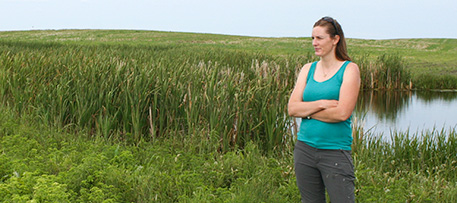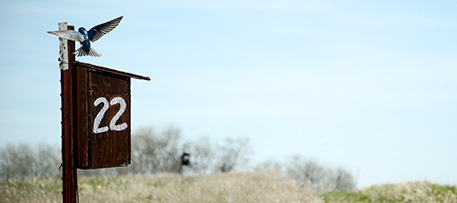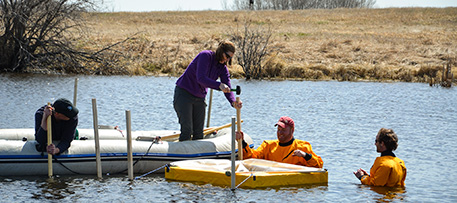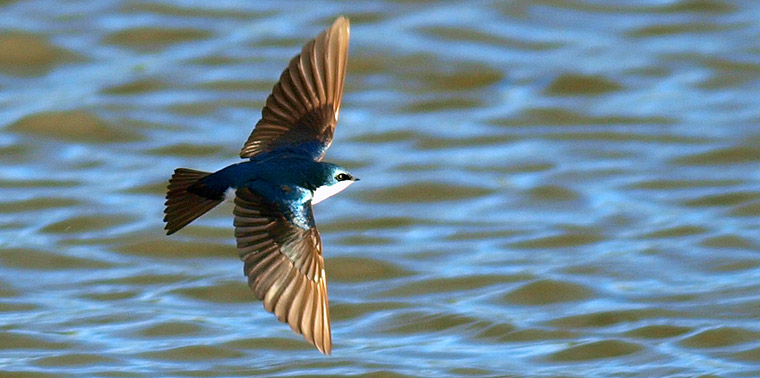September 25, 2014 — Editor’s note: This article is reprinted with permission from Environmental Health News, a foundation-funded news service. It is part of EHN’s Winged Warnings series.
![]() Christy Morrissey is driving her white pickup truck along Canada’s endless prairie highway, windows open, listening for birds. She points to the scatter of ponds glinting in the landscape, nestled among fields of canola that stretch as far as the eye can see.
Christy Morrissey is driving her white pickup truck along Canada’s endless prairie highway, windows open, listening for birds. She points to the scatter of ponds glinting in the landscape, nestled among fields of canola that stretch as far as the eye can see.
Formed by retreating glaciers 12,000 years ago and fed each spring by melted snow, these tiny potholes are the lifeblood of the prairies, the kidneys that drain impurities and the cradle that replenishes life.
But when Morrissey looks at these ponds, she sees something few others do. An ecotoxicologist at the University of Saskatchewan, she knows that nearly every pond is laced with neonicotinoids, the world’s most widely used insecticides, deadly to insects at a minute dose of a few parts per trillion.
Morrissey is mounting a scientific quest to figure out if these new pesticides are harming living things they’re not intended to kill, including birds.Like biologist Rachel Carson, whose 1962 book Silent Spring warned about the devastating effects of DDT and led to its U.S. ban, Morrissey is mounting a scientific quest to figure out if these new pesticides are harming living things they’re not intended to kill, including birds. Morrissey is part of a new generation of scientists in North America and Europe investigating a new generation of chemicals. Growing up reading Carson’s work, these researchers are now using more sophisticated diagnostic tools to continue the work Carson started more than a half-century ago.

Ecotoxicologist Christy Morrissey is on a quest to discover how pesticides known as neonicotinoids might be affecting wildlife and ecosystems. Photo by Alanna Mitchell.
“Both Christy and Rachel started in the same place, with a profound appreciation for wildlife and natural systems,” said Cynthia Palmer, director of pesticide science and regulation for the American Bird Conservancy, an advocacy group in Washington, D.C. “Both came to realize that the chemical cocktails of their day threatened to derail conservation efforts for the wild organisms they studied and cared about.”
Unlike DDT, neonicotinoids don’t appear to accumulate in the tissues of warm-blooded creatures, but they may have other subtle, widespread effects that Morrissey and other researchers are only now beginning to pinpoint. Several studies have found that the chemicals are killing so many ecologically important insects that they are having widespread effects on whole ecosystems, particularly bees. In addition, evidence is mounting about effects on birds: In the Netherlands, birds are declining in proportion with neonicotinoid levels in surface waters. In the Canadian prairies, Morrissey’s early results suggest that birds and chicks are unhealthier near the treated fields. An experiment in Spain found that when captive partridges consumed neonic-coated seeds, they had fewer chicks and suppressed immunity. And one analysis concluded that birds might be poisoned if they eat just one or two seeds.
Born two years after the 1972 DDT ban, Morrissey said its legacy and lessons – which she still teaches to her students – underpin how her generation of chemical sleuths investigates these new compounds. Ecotoxicologists today, she said, are at the forefront of informing a public that has become complacent about the dangers of chemicals.
“In this field we all have to have some bulldog in us, some tenacity,” said Karen Kidd, an ecotoxicologist and Canada research chair in chemical contaminants of food webs at the University of New Brunswick. Morrissey, she said, is tackling some of the toughest emerging questions. “We’re driven to find out what’s going on.”
But Morrissey, like most scientists, is not a campaigner; she’s a cautious investigator. The key ingredients of her work are striving for impeccable methodology, refusing to draw conclusions ahead of the facts and continuing to press for answers to new questions. Pierre Mineau, an expert on pesticides and their effects on birds who served with Morrissey on a global task force on systemic pesticides, said she frequently pushed the members of that group to be more moderate in their conclusions. But on the other hand, he said, once the science is clear, she refuses to pull her punches.
A basic question haunts Morrissey. Bug-eating birds are in decline, and if that’s from unintended consequences of pesticides used worldwide — as it was for DDT in the 1960s — she wants to know so she can advise regulators. Because of this, Palmer calls her “the most important researcher out there” when it comes to neonicotinoids and birds.
“Sometimes I feel like it’s a Hydra: You cut off one head and several more spring up.” — Cynthia de WitIt helps that new tools allow today’s scientists to find concentrations in the parts per trillion, unimaginably low to researchers even a few decades ago, but, as it turns out, significant to some creatures. Even though concentrations are often low, the sheer number of manmade chemicals in the environment today is much greater and the span far wider than during Carson’s days.
“Sometimes I feel like it’s a Hydra: You cut off one head and several more spring up,” says Cynthia de Wit, a professor of environmental science at Sweden’s Stockholm University who studies wildlife and human exposures to an array of chemicals. “It becomes almost a frantic feeling. You’re just looking at one and they’ve developed 10 more. You just can’t keep up with the pace.”
Intense and Increasing Scrutiny
Four years ago, when Morrissey was 36 years old, fresh out of a postdoc in Wales and newly arrived on the prairies, she didn’t even know what neonicotinoids were, much less that they were contaminating prairie waters. In fact, she’d never heard of them until she called Mineau, who then was working with Environment Canada. She asked his advice about what to study.
He said: “Neonicotinoids!” She paused for a beat. And then she said: “You’re going to have to spell that for me.”
Now accounting for one-third of all insecticides used globally, the neonicotinoid market was worth $2.63 billion in 2009 and is on the rise.Today, these pesticides, cherished by farmers for the past 20 years for their effectiveness in killing crop pests, are under intense and increasing scrutiny around the world. They are used to coat most canola and corn seeds and many soy seeds in North America, as well as treat some fruit and vegetable crops and garden plants. The best-selling neonicotinoid compound, imidacloprid, is registered for use on more than 140 crops in 120 countries and is used in more than 400 products sold in the United States, according to the National Pesticide Information Center. Now accounting for one-third of all insecticides used globally, the neonicotinoid market was worth $2.63 billion in 2009 and is on the rise.
Last year, the European Commission banned neonics on some crops for two years due to concerns that they are poisoning bees. The U.S. Environmental Protection Agency, which says its scientific conclusions about acute effects on bees are “similar” to those that led to Europe’s ban, plans to complete its review of neonicotinoids in 2016 or 2017. Canada’s most populous province, Ontario, is considering reducing or eliminating them; honey producers there filed a $360-million class action lawsuit against the two main manufacturers.
Morrissey says the effect on bees is only one piece of a more complex picture. Even more important to her is the pesticides’ presence in water, and what might be happening to the creatures that depend on the water – especially birds.
Morrissey knows that if neonics are playing a role, it’s a subtle one.It’s clear that the biggest threat to prairie birds is the loss of the places they live due to conversion to farmland, cities and other human development, according to the Cornell Lab of Ornithology. But some birds, including swallows and others that scoop up insects as they fly, are in sharp, recent decline across Europe and North America for unknown reasons. Barn swallow numbers, for example, have plummeted 70 to 80 percent in the past few decades, a phenomenon that has scientists mystified. One of the few links among these imperiled flying bug-eaters is that many of them nest in areas where pesticides are common.
But Morrissey knows that if neonics are playing a role, it’s a subtle one. They aren’t the virulent, obvious bird-killers that some older chemicals were, poisoning hawks, eagles and robins and depleting their populations by thinning their eggs. Nevertheless, she wondered, could neonics be posing an indirect, potentially more widespread threat to birds?
Going to the Heart of an Ecosystem
Growing up in Vancouver, British Columbia, Morrissey didn’t start off interested in pesticides or toxicology. She wanted to be a veterinarian and got her first degree in zoology. But an internship in the late 1990s changed everything when several scientists in the Canadian Wildlife Service were trying to figure out what was killing bald eagles in British Columbia. They hired Morrissey to help. “My eyes just opened to possibilities I didn’t know about,” she said.
It turned out that the bald eagles were eating the corpses of ducks that had died after consuming crops treated with a class of pesticide that came before neonics and after DDT: the cholinesterase inhibitors such as carbamates. There was still so much pesticide in the ducks’ bodies that the eagles that fed on them were poisoned, too. Morrissey and her colleagues were rushing to find antidotes and even to get the sick eagles into veterinary labs so surgeons could cut into their gullets and remove the poison. It was the most exciting work she could imagine, going right to the heart of how a whole ecosystem works.
“It ticked all the boxes for me,” she says, driving along a Saskatchewan highway, on her way to check some of her field stations.
A couple more degrees and a four-year stint in Wales after her Ph.D., and Morrissey found herself in Saskatoon in 2010 with a teaching position, grad students, a new pesticide in her vocabulary and a $5,000 grant to map where neonics were being used and how much was left on the land. She was shocked to learn that more than 27 million acres of Canadian prairie were seeded with canola and that virtually every seed was covered with neonics — either in pink or in blue, depending on the manufacturer — before it was planted. And that didn’t count all the other crops, such as corn, soy, oats and barley, planted with treated seeds.
Morrissey started wondering whether the chemical stuck around like DDT did. So in the spring of 2012, with her grad student Anson Main, she sampled 136 potholes before crops were seeded, just to get baseline measurements of their chemistry. They didn’t expect to find neonics in the water, so they were surprised that more than one-third of the ponds contained at least one neonic compound that spring. That number rose shortly after seeding, as expected, and fell in the fall.
But the real shocker came the following spring — 2013 was a wet one — when they tested the same ponds again before seeding. Ninety-one percent of the ponds contained neonics at levels toxic to insects. Their conclusion: The chemicals must persist in the soil and then be washed into ponds. In other words, they not only stick around, they migrate far beyond the fields they are intended to treat.
For an ecotoxicologist like Morrissey, all this was a game-changer.A similar phenomenon was reported across the U.S. Midwest. Neonics were present in rivers throughout Iowa – where corn and soybeans treated with the chemicals are grown intensively, in watersheds stretching more than 320,000 square miles. The chemicals were found “more frequently and in higher concentrations” than earlier generations of pesticides, the authors said.
For an ecotoxicologist like Morrissey, all this was a game-changer. Pesticides’ toxicological profiles fall into two categories, either acute or chronic, according to how long they last. A pesticide that kills and then vanishes quickly is assessed as an acute toxicant. The ecosystem can tolerate high levels but only for a short period. If it persists for 10 percent or more of a creature’s lifespan that means it needs to be assessed as chronic or long-term. And that means the amount that can cause harm is far lower because it’s spread out over time. Morrissey’s pond results meant that neonics now had to be examined through the lens of the long-term toxicant.
To make matters more pressing, Morrissey’s lab results showed that neonics were far more toxic to some insects than the manufacturers’ studies had shown. To obtain approval for use, the companies performed short-term toxicity tests on the water flea Daphnia magna, a standard for pesticides. But Morrissey’s work showed that the water flea, a crustacean rather than an insect, is unusually insensitive to the chemicals – about 1,000 times less sensitive than the average of all other species tested. When neonics are tested on key wetland insects such as midges, caddisflies and mayflies, they are between 10,000 and 100,000 times more toxic than they are to the water fleas. That means that ecologically important invertebrates are likely affected at levels already present in the wild.
“It’s now crystal clear. Neonicotinoids have the chemical properties of long persistence, solubility in water and acute toxicity to some insects,” Morrissey says. “And that triggers concern.”
It was only the beginning.
A Breakthrough in Insecticides
When neonicotinoids came on the market 20 years ago, ecotoxicologists and pesticide regulators were optimistic. Older generations of pesticides, including carbofuran, were severely toxic to warm-blooded animals. The cholinesterase-inhibitors essentially cause the “biological equivalent of a short-circuit” in nerves, Mineau said. In fact, they were derived from nerve-gas research in Germany during World War II, he said. Neonics, derived from nicotine, also are nerve toxins but they have a much greater effect on insects than on birds or people. They were seen as a breakthrough.
There are environmental pluses to neonics: Because coating seeds is a precise method of delivering pesticide to a plant, whole fields no longer need to be sprayed.Not only that, but neonics are used in agriculture differently than earlier pesticides. Manufacturers, including Bayer AG and Syngenta AG, coat seeds with the pesticide and then seal the seed with plastic. The manufacturers point out in a recent report that this means there are environmental pluses to neonics: Because coating seeds is a precise method of delivering pesticide to a plant, whole fields no longer need to be sprayed. That means the chemical is targeted to the plant itself. The chemicals infuse each part of the plant as it grows, pushing the pesticide molecules into roots, stalks, seeds, leaves, pollen and nectar. This is known as a systemic pesticide because it affects all tissues, all cells. Sometimes, farmers apply the pesticide after the plants have grown as well.
But Morrissey and Mineau point out that the phenomenon of coating seeds means that for lots of crops, including canola, soybeans and corn, seeds are treated whether the crop is at risk of pest damage or not. Overall, that means the pesticides are applied to vast numbers of acres. The old pesticides such as carbofuran had a half-life in the environment of three or four days; for neonics, it’s over a year in the soil, and in some cases, as much as 12 years.
A groundbreaking 2013 report by Mineau and Palmer for the American Bird Conservancy argued that birds might die from eating just one or two coated seeds. So far, however, there are only a few reports of birds being possibly poisoned in fields.
For insects, a growing body of research suggests that neonic molecules are having unexpected effects. Alex Lu of Harvard University and others have linked them to colony collapse disorder, a phenomenon affecting farmed honeybees whose adults mysteriously die or vanish. As well, because the pesticide remains in pollen and nectar in small quantities, it can have chronic effects on pollinators such as bees. For example, a recent study in England found that bees equipped with microchip radio tags didn’t show big effects before at least two weeks of low exposure. Rather than being able to hone and improve skills of collecting and bringing back pollen, the bees exposed to neonics actually got worse at those tasks over four weeks, said Nigel Raine, study co-author and research chair in pollinator conservation at the University of Guelph in Ontario.
This implies that the pesticides are altering bumblebees’ learning and memory. And that, in turn, implies that there could be other unforeseen consequences.
Cataloging Effects
Two years ago, once Morrissey realized that neonics could leach into water long after they were applied, and that they had lethal effects on so many beneficial insects, she began the second stage of her research, which is still in progress: cataloging their effects on specific insects in the wild, and analyzing the health of tree swallows in areas of intensive farming with neonics. This is notoriously difficult science because it is about indirect effects. It takes stages of analysis: First, what is happening to insects; second, what is happening to birds; and then, third, whether the first is connected to the second. Most scientists shy away from this study design because it is painstaking. “Thank God that didn’t deter me,” she says.

A swallow alights on a nest box, part of a long-term study of nesting success near agricultural lands. Photo by Alanna Mitchell.
She’s parked the truck next to a row of wooden boxes where tree swallows have built their nests, a proxy for the tree cavities they like. This is one of five research sites, some near intensive farming using neonics and some in unfarmed land. She wades through the tall grass, flicking off ticks and batting away mosquitoes, and opens the box. Inside are 12-day-old tree swallows, peeping. She collects three in a cloth bag and wades back to the truck. Here, she bands each tiny leg with an individual number that will let her identify the bird if it’s caught again, measures and weighs each nestling, draws a few drops of blood from each and carefully plucks a couple of downy feathers for chemical analysis that will give a signal of how much food stress each bird is under. She repeats this ritual throughout the day, marking her actions on a chart. She and her grad students will band every 12-day-old tree swallow chick across the five research sites – hundreds of birds in all.
Preliminary results indicate that the birds at agricultural sites are in poorer condition than those farther away from the chemicals.Over the years, Morrissey and her team will track whether these birds return to the nesting sites to make their own families, whether they have their own chicks and, maybe, whether they die or survive. Preliminary results indicate that the birds at agricultural sites are in poorer condition than those farther away from the chemicals. There’s a slight delay in the breeding time of the adults in the neonic-treated areas and their chicks are less healthy. “We’re starting to build a picture of who they are and what their survival rate is,” she says.
The hypothesis she’s testing is that these birds are having a tougher time finding the flying insects they eat, and that affects this crucial period of the birds’ life history after their migration. When they arrive on these prairies in the spring to breed, they are thin and depleted so they need food – lots of it. Then they need more food as they lay eggs and even more to feed their nestlings. The life of these birds revolves around bugs. Her research has already determined that tree swallows vastly prefer midges to other food, and midges are exquisitely sensitive to neonics even in tiny amounts.
In the Netherlands, insect-eating birds have declined in numbers since neonics began to be used on crops there, and the decline worsened with higher water concentrations of the chemicals, according to a study published in the journal Nature in July. “Our results suggest that the impact of neonicotinoids on the natural environment is even more substantial than has recently been reported and is reminiscent of the effects of persistent insecticides in the past. Future legislation should take into account the potential cascading effects of neonicotinoids on ecosystems,” concluded the study by Caspar Hallman and others of Radboud University.
In addition, a study in Spain that fed partridges neonic-coated seeds reported that the chemicals led to smaller, thinner eggs and fewer surviving chicks, as well as suppressed immune systems. The scientists said their results “suggest that treated seeds…may constitute a risk for farm-land birds,” although they added that the real-life exposure of wild birds has not been quantified.
Morrissey also is conducting a novel experiment on a Saskatchewan pond where she and her grad students have set up 21 separated columns in the water, anchored in the sediment. Each is covered with a tent and Plexiglas traps filled with alcohol to capture all the insects that emerge from the water. The columns are dosed with different levels and combinations of neonics – in addition to two controls not dosed – at concentrations that already are common in prairie wetlands. The aim is to measure whether the abundance of insects in the wild is affected by neonics, the first study of its kind. Early results suggest that the same insects shown in lab tests to be affected at the levels commonly found in the wetlands are failing to hatch in the wild pond as well.

Researchers install a “limnocorral” to trap insects for study. Photo by Brandon White.
This summer, an analysis of more than 800 peer-reviewed studies of neonics and other systemic pesticides, conducted by an independent task force of scientists including Morrissey and Mineau, concluded that the chemicals are “likely to have a wide range of negative biological and ecological impacts.” Harkening back to DDT and the cholinesterase-inhibitor chemicals, the task force said that systemic insecticides, including neonics, “represent a new chapter in the apparent shortcomings of the regulatory pesticide review and approval process that do not fully consider the risks posed by large-scale applications of broad-spectrum insecticides.” The potential risks to people are unknown; no substantial studies of human effects have been conducted.
“A Concerted and Ill-conceived Campaign”
Manufacturers of neonicotinoids see all these studies in a different light. The European Crop Protection Association, representing the manufacturers, said in a statement that the task force’s conclusions do not represent a “robust assessment of the safety of systemic pesticides under realistic conditions of use,” and accused the scientists of relying on worst-case scenarios and of being “part of a movement that brings together some academics and NGOs whose primary objective is to restrict or ban the use of neonicotinoid technology regardless of what the evidence may show.”
The industry group said the scientists are overlooking the economic and environmental benefits of using neonics. A European study paid for by Bayer CropScience and Syngenta, two of the largest manufacturers of neonics in the world, found that neonic seed treatments contribute more than 2 billion Euros a year to commodity crop revenues in Europe and reduce the cost of producing them by nearly another billion Euros.
The European industry association accused the authors of the Netherlands bird study of being part of “a concerted and ill-conceived campaign against neonicotinoids rather than a genuine pursuit of good science and solutions for safeguarding our environment.” The group said that the bird declines could stem from other problems, such as climate change.
“The notion that you’re really going to be able to extend that potential indirect effect to an effect on birds is a pretty big stretch.” — Mike LeggettMike Leggett, senior director of environmental policy at CropLife America, which represents pesticide companies, noted that the study in the Netherlands failed to assess whether the birds’ nutritional needs were met or not, and noted that just six of the 15 bird species investigated were in decline.
When it comes to Morrissey’s work, Leggett said that he’s keenly interested to see her results on aquatic insects and wonders whether she will prove any effects on birds. “The notion that you’re really going to be able to extend that potential indirect effect to an effect on birds is a pretty big stretch,” he said. “We really haven’t seen any evidence of that in the environment.”
Leggett emphasized that the neonic levels Morrissey is finding in wetland waters are “very, very low,” and that they are not “a cause for concern.” He said that the levels in prairie potholes and their persistence are “not entirely unexpected” given industry’s own scientific models. “They don’t suggest to me an imminent risk to aquatic life in prairie potholes or to any other organisms depending on that aquatic life, like birds,” he said.
Morrissey isn’t surprised by what industry is saying about her work or the claims that the levels found in those prairie potholes are safe. It’s industry’s job to promote the products; it’s hers to investigate their safety. “We have different perspectives on the issue and I accept that we will always likely disagree,” she said.
Carson faced virulent attacks when she published her results and so have others who have tried to investigate the safety of pesticides worth billions of dollars a year in sales. So far, apart from general accusations that some scientists are on an anti-neonic “campaign,” industry’s criticisms have not been personal, only vehement.
Few Answers, Lots of Questions
Morrissey, who is back in her truck heading home after a day in the field, doesn’t claim to have all the answers yet. In fact, the answers she has collected simply lead to more questions. “I feel like we’re just getting the glasses on, starting to sharpen the picture little bits here and there. As it sharpens, as we see things, we start asking more questions,” she says.
For instance, there is not just one neonic; there are several. It’s unknown whether they add up in toxicity to aquatic bugs, but early signs suggest they do. And as they break down, they produce other chemicals that also may be toxic.
She shrugs. Finding answers to these questions is a first step toward decoding the puzzle.
If neonics are dangerous, regulators can do something about it, just as they did with DDT after Carson’s work.
“We’re losing birds. That’s what’s happening. It’s indisputable,” she says, eyes scanning the fields and ponds. “If we talk about really conserving birds, then we need to figure out whether neonics are the biggest factor or whether it’s something else. If it is one of the major problems, it’s one we can actually do something about.” ![]()
Ensia shares solutions-focused stories free of charge through our online magazine and partner media. That means audiences around the world have ready access to stories that can — and do — help them shape a better future. If you value our work, please show your support today.
Yes, I'll support Ensia!
